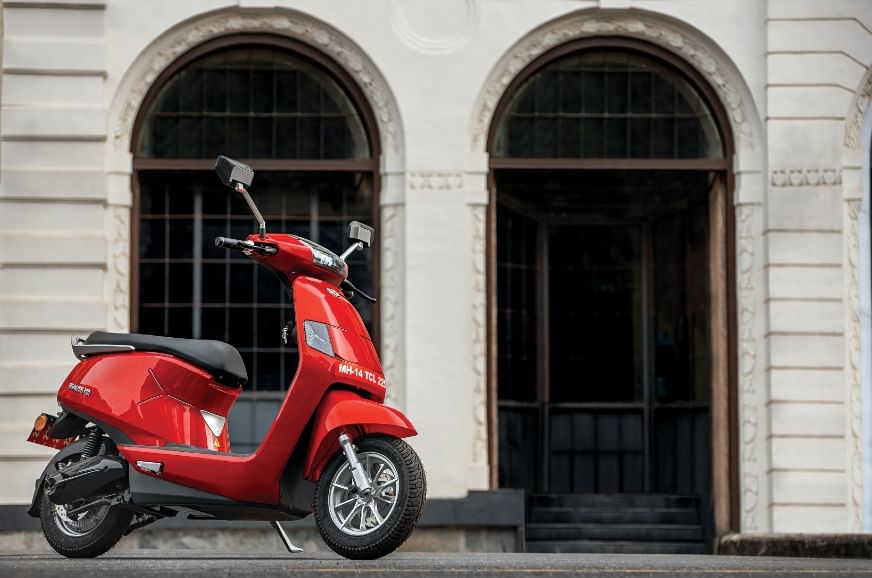BGauss B8 review, test ride
BGauss takes a shot at the Indian electric two-wheeler space.
Published on Oct 09, 2020 12:00:00 PM
30,211 Views
BGauss is the latest company under RR Global’s umbrella. If you haven’t heard of it, RR Global is an electrical conglomerate that claims to be worth USD 800 million (about Rs 5,974 crore). The company’s products include wires, copper tubes, magnet wires, consumer electrical products, among other things. With BGauss, RR Global marks its entry into the growing two-wheeler EV market in India.
Despite its large backing, BGauss doesn’t take on the premium, made-in-India EV space that consists of the Ather, Chetak and the TVS iQube. Its scooters are positioned in the more affordable, lower-performance segment that sits below it. And like the other scooters in this space, it originates from the land of the red dragon.

Close quarters
The BGauss B8 is small. Its compact dimensions are similar to those of the TVS Scooty Pep Plus, but smaller still, and it is not as long and has a smaller seat. Going this route does make it accessible to the shorter female demographic, not just because of the low seat height, but also because it feels quite light and easy to manoeuvre. On the flip side, it doesn’t have enough room to comfortably accommodate a pillion. Another drawback is that it doesn’t have the presence of a full-sized scooter, which might be a put off for some.
That said, its puny size doesn’t diminish the amount of attention it gets. The simple yet futuristic styling elements are well executed. The LED headlight looks straight out of a sci-fi movie and it’s quite powerful as well. Similarly, the integrated turn signals and tail-light have a neat layout too. The bodywork is angular, but also smooth flowing at the same time, and it doesn’t look overdone from any angle, which is quite refreshing in this segment.
What’s also nice is that the bodywork doesn’t look like it was made on a shoestring budget and even the quality of the paint is quite nice. It’s also devoid of any unnecessary decals and only features simple badging at the front and the sides. The B8’s alloys, side stand and pillion foot pegs also don’t look ultra-low cost. However, we do wish the pillion foot pegs fitted a little more flush with the body panel. Also, the mirror stalks kept working themselves loose despite us tightening them a couple of times.
As for the seat, it’s not very spacious but that’s down to the overall size of the scooter. The seat’s closing mechanism, though, wouldn’t work as it should and it required more than a couple of tries each time. Something else we found quite flimsy was the panel that separated the battery and the underseat storage. Like the seat, its locking mechanism could have been better as well.
Tech talk
The B8 is available in three variants - a Lead Acid model, the Lithium-Ion powered version we rode and a Lithium-Ion Technology that gets Bluetooth connectivity. All three models use the same instrument cluster which is quite nice. It’s laid out well and bright enough. It displays the speed, odo, riding mode and a battery level gauge.
Speaking of the switches, the ones on the B8 look nice, but aren’t very easy to use because they’re placed a little too close to each other. Like every other Chinese-origin e-scooter we’ve ridden, this one features a key fob that lets you activate the alarm system. This security system will begin ringing and also lock the hub-mounted motor if the scooter has been moved.
Speaking of the battery, the BGauss’ 1.45kWh unit is removable. This means you can either plug your charger directly into the battery or into the charging socket that sits near the footboard. The battery itself weighs around 13kg, which makes it a workout to carry home, but the convenience of having this option is quite nice.
Turn it up
Propulsion on the B8 comes from a Bosch BLDC hub-mounted motor. Power stands at a claimed 800W (continuous) and 1,900W (Peak). The company also says that the motor is IP67-rated and the controller is IP65. While the company’s website claims that the scooter has a 50kph top speed and a range of 70km, we got slightly lower figures in our tests.
The BGauss B8 has three riding modes – 1, 2 and 3. While these modes are only said to increase the top speed as you go to a higher number, our tests revealed that mode 1 did reduce the acceleration slightly. Modes 2 and 3, meanwhile, returned similar numbers where it reached 30kph in around 6sec. The scooter also has a boost button that can be used for overtakes, and with it pressed, we got to 40kph in 11sec. The true top speed we achieved was 44.55kph, while the speedo indicated 49kph.
In comparison to other China-sourced electric scooters, the BGauss is faster than the more-affordable Ampere Zeal, but nearly 4sec slower to 40kph than the Gemopai Astrid. The Okinawa Praise Pro, meanwhile, is 3sec quicker than the BGauss. The Okinawa also has a much faster top speed of around 55kph. However, none of these scooters match the performance offered by EVs from Ather, Bajaj and TVS.
The range we achieved while riding at regular city speeds was 47.5km (Mode 2), at which point the battery ran flat and I had to push the scooter home. This puts it on par with its rivals. Another figure that’s also close to that of its rivals is its charge time of around three hours. What was nice is that the BGauss didn’t lose much performance as the battery charge dropped. I managed to get to a speedo-indicated 42kph with just two bars of battery left.
Make a move?
Like many low-cost, imported EVs, the BGauss has a sharp initial response when you open the accelerator at low speeds, especially when you’ve just come off the brakes. The B8 has another common annoyance we’ve experienced in this segment – the accelerator will get disconnected if you even slightly trail either of the brakes and this can put you in a tricky situation while taking U-turns or tight turns in traffic. Something else that takes getting used to is the riding position, and like some of its rivals, the footboard on it is a little higher than normal. This puts you in an uncomfortable position where your knees are higher than your hip.
The scooter rides on 10-inch Ceat tyres that are reasonably grippy for the speeds it is capable of. Suspension on the BGauss B8 is handled by a telescopic fork and twin shock absorbers. The ride quality this setup grants is nothing to write home about. It’s decent until you hit a pothole or bump at higher speed, where it thuds in a fairly harsh manner. The brakes, on the other hand, are quite powerful. The B8 is equipped with a disc brake setup at both ends with CBS, but the rear will still lock under a hard pull at the lever.
Pulling the plug
BGauss is also a completely new company and claims to have six showrooms, with 25 planned by March 2021. At the moment, it’s far too early to know what the sales and aftersales experience will be like. With a price tag of Rs 83,000, the B8 takes on competition like the Gemopai Astrid Lite (Rs 82,000) and the Okinawa Praise Pro (Rs 79,000).
The BGauss B8 has a few things going for it like the simple yet futuristic styling and impressive headlamp. That said, its size will appeal to some, but will be a deal-breaker for others. It also doesn’t have the performance to keep up with fast-moving traffic in a city like Mumbai. If you’re okay with this, the B8 should work as a stylish option for short-distance runabouts.
Related Videos
Tech Specs
| Wheels and Tyres | Petrol |
|---|---|
| Front wheel (inch) | 10 |
| Rear wheel (inch) | 10 |
| Dimensions & Chassis | Petrol |
|---|---|
| Weight (kg) | 76.5kg |
| Ground Clearance (mm) | 139mm |
| Price | Petrol |
|---|---|
| Price Range Ex-showroom - Delhi | Rs 62,999-88,999 |
| Engine | Petrol |
|---|---|
| Motor | Hub-mounted BLDC |
| Battery capacity | 1.45kWh |
| Battery type | Lithium-ion |
| Efficiency | Petrol |
|---|---|
| Overall (kpl) | 47.5km |
| Acceleration | Petrol |
|---|---|
| 0 - 10 kph (sec) | 1.12 |
| 0 - 20 kph (sec) | 2.95 |
| 0 - 30 kph (sec) | 5.95 |
| 0 - 40 kph (sec) | 11.00 |
| Max speeds in gear | Petrol |
|---|---|
| Top Speed (kph) | 44.55kph |
| Suspension | Petrol |
|---|---|
| Front Suspension | Telescopic fork |
| Rear Suspension | Twin shock absorbers |
| Brakes | Petrol |
|---|---|
| Front Brake Type | Disc |
| Rear Brake Type | Disc |
Copyright (c) Autocar India. All rights reserved.



